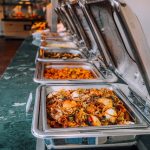
In traditional Spanish gastronomy, wild or mountain meats abound, delicacies requested throughout the year, but especially in the autumn season.
Deer meat is characterized by having a high consistency and being low in fat. A good solution to provide a more honeyed texture to this deer meat is maceration.
Marinating meat is a very useful culinary resource, its objective is to soften the food, changing its texture and enhancing its flavor to the maximum.
One of its functions is to preserve meat, but it is most commonly used to increase aroma and reduce toughness.
So, the answer to how to marinate venison is as follows: we will use squeezed lemon juice, wine or even some type of liquor and, of course, a wide variety of aromatic herbs or spices.
It is essential to let the mixture with the deer meat rest in the refrigerator for at least 24 hours before cooking. A secret so that it absorbs the aromas even more is to move it frequently during that rest time.
Marinade deer meat with red wine
A very common way to marinate meat is to use a quality red wine. An example is the deer civet: a dish recommended by many meat experts, with an exquisite flavor.
The maceration of this dish is usually accompanied by vegetables that increase its aroma and that are later used to serve on the plate.
Macerating Deer Meat With Red Wine
Ingredients needed
800 g of deer loin.
Red wine.
Onions.
Several cloves of garlic.
Port.
Pepper.
Carrots.
Thyme.
Rosemary.
Oregano.
Laurel.
Ground pepper.
Coarse salt.
Flour.
Extra virgin olive oil.
Preparation of deer civet
The first thing is to cut the deer loin into large cubes and the vegetables to be added chopped with the wine. It must macerate in the refrigerator for 24 hours. All these ingredients have to cover the meat in half and it is necessary to turn it every 3 hours so that it acquires flavor.
Remove the germ from the garlic. Both the salt and the spices and the amount of vegetables, he thought of the taste of each one.
Season the meat with salt and pepper and lightly flour it.
Fry the meat in a pan with oil, until it is sealed.
Place all the vegetables with the spices and the meat in a pot.
Add a glass and a half of wine and one of water, and heat over high heat for 5 minutes.
Lower the temperature of the fire, and let it cook over medium heat for two hours. It is important to add more water or wine if necessary so that the meat does not dry out.
To finish, remove the meat and beat the vegetables with the sauce.
As an accompaniment to this dish, a mashed potato or some cooked apples is ideal.
It is also optional to add, in the last ten minutes of cooking, dried figs, dried apricots or raisins and remove them before mashing the vegetables with the sauce.
Macerate deer meat with lemon
Another very common method for macerating deer meat is using lemon. It is a very simple and nutritious recipe.
As a garnish it is ideal to add a sauteed mushroom with fried eggplant.
Macerate deer meat with lemon
Ingredients needed
Deer tenderloin.
Pepper.
Parsley.
Garlic.
lemon.
Oil.
Salt.
Optionally some mushrooms and eggplant.
Preparation of marinated deer tenderloin
Clean the venison tenderloin with water and remove the fat.
Finely fillet the entire sirloin.
Cover the already laminated fillets with the mixture of lemon juice, garlic, pepper, parsley, salt and oil.
Let marinate in the refrigerator, the ideal time would be 48 hours.
When the maceration process is over, it is necessary to cook the fillets on a griddle or in a frying pan at maximum temperature. Then you should add the sauce left over from the macerate.
Finally, as a garnish, you can add a stir-fry of vegetables or mushrooms, with fried aubergines or fried courgettes, instead of always resorting to the typical potatoes as a side dish.
Tips for marinating deer meat
It is important to take these guidelines into account so that the meat maceration process is adequate:
Lower the temperature when macerating with sweet wines, since food can be burned more easily by sugar.
The mash should cover the food.
Stir frequently to favor the maceration of the meat.
Do not reuse the mash liquid for other foods.
1. Preparation of raw materials
The first step is, of course, the preparation of the raw material. That is, the processing of meat from healthy and well-nourished animals with the proper pH and optimal hygiene conditions.
One of the most important aspects of preparation is the application of cold treatments to always maintain the right temperature. This is vital to prevent this raw material from decomposing and to prevent the development of any microorganism that could affect its quality.
2. Chopped
To mince the raw material, mincing machines are used that fragment and cut the meat according to the sausage that is going to be made. And it is that some sausages need larger pieces, such as chorizos, and others need much finer pieces, such as salami.
The chopping process must be done with the raw material at a certain temperature, so that it does not overheat, and with blades with an adequate sharpness.
3. Mixed and kneaded
Once the meat is minced, it is taken to mixing-kneading machines with a rotating blade that turns the raw material into a uniform mass.
This process is also carried out at certain temperatures, normally less than 4 degrees Celsius, to prevent the meat from taking on an inappropriate texture.
4. Sausage
Once the mixture is prepared, it is time to make the sausage. In other words, fill the casings with the preparation.
Of course, care must always be taken that the casings, whether natural or artificial, are well washed before being stuffed. It is important to remove all the salt that it may have so that no crust forms on the surface of the sausage.
5. Cooking and smoking
To give the sausage a firm consistency, it is normally subjected to a process of cooking, smoking, or even both.
Furthermore, smoking gives it a characteristic colour, flavor and aroma.
6. Ripening and drying
Since the fresh mass of the sausage is susceptible to decomposition, the maturation and drying process is essential. It is what is called the “curing” of the preparation.
During this period, carried out with specialized equipment, a series of biochemical, physical and microbiological transformations take place in the product, which give it the necessary stability to reach the customer’s table with the highest quality.
7. Conservation
One of the keys to ensure a 100% suitable product for consumption is its preservation. In general, sausages, bolognas and other cooked products must be refrigerated.
Cured products such as chorizo, sausage and the like can be kept outside the refrigerator.
Likewise, conservation factors must be taken into account in addition to temperature, such as light, humidity, etc.
Why are you interested in knowing how sausages are made?
Now that you know the entire procedure for making sausages, you will know that each step is essential.
In the store where you buy your sausages and the professionals must be able to assure you that each step has been completed and they must indicate the conditions that you must maintain in your home to preserve the product you have bought.
We can assure you and we guarantee 100% handmade products. Do you dare to try them?



